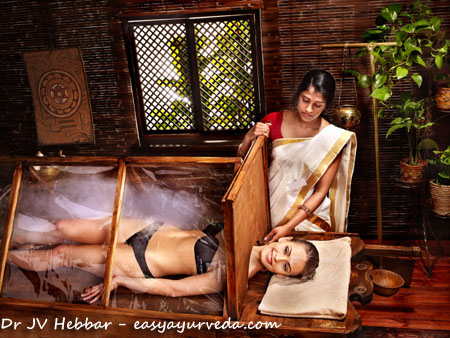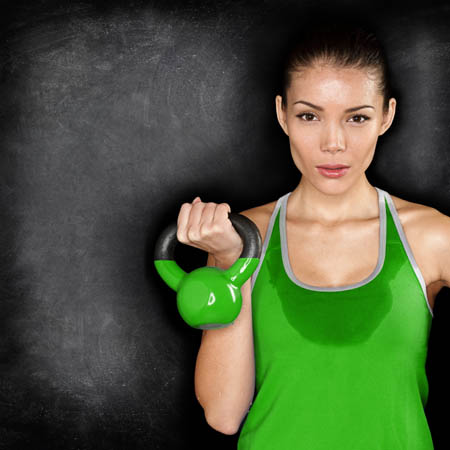Why You Should Sweat – To Treat Disease, For Better Health

In the movie “Wolf Of Wall Street”, Jordan Belfort installs a steam therapy machine into his house. He was a drug addict. Everyday morning he gets a steam therapy to expel out all the remnant drugs that he took last night, so that he can start his day afresh. So, if he can expel out all the drugs, sweating can expel many toxins out of your body as well. Sweating is a form of therapy, explained in Ayurveda. It is also known as fomentation therapy.
Table of Contents
Contraindications
Who should not try sweating treatment:
If you already sweat a lot.
Who consume alcohol on daily basis – Because they already sweat a lot.
Pregnant woman – Sweating is a kind of cleansing procedure, it takes away some strength out of the body, hence, not ideal for pregnant.
Those suffering from bleeding disorders such as nasal bleeding, rectal bleeding etc – Bleeding disorders are associated with Pitta Dosha. Sweating increases Pitta, hence, not ideal for them.
During periods and women with heavy periods problem – Pitta is dominant,
People with Pitta body type
Diarrhea, dysentery – already the body is losing water, hence, sweating is not ideal.
people with excessive dryness, – sweating in them might cause bleeding.
chronic urinary disorders, diabetes – Pitta will be involved in them.
inflammation and prolapse of the rectum, burn injuries, toxic conditions,
Those who are fatigued, unconscious,
very obese people, who are very thirsty, hungry, – already they will be sweating or Pitta will be aggressive.
who are suffering from anger and anxiety
Those suffering from jaundice, abdominal diseases, Vatarakta (gout),
Those who are weak, debilitated and dried up and whose Ojas has been reduced – because sweating involves strain and it is a cleansing procedure.
wounded, injured
patient with herpes, other skin disorders involving redness, bleeding and burning sensation
Shosha – emaciated
who have recently consumed milk, curds, fat,
Who have just undergone Virechana treatment
Who are burnt,
Who are tired, suffering from anger, grief, fear, excess thirst, hunger,
liver diseases, anemia, people with Pitta imbalance.
Indications
To whom sweating is ideal to follow –
Disorders involving Vata and Kapha Dosha
Cough, COPD, Asthma – in them, sweating helps to expel the sputum out pretty easily.
Pratishyaya – running nose, allergic rhinitis – it is basically a Kapha dominant condition, sweating in them helps to improve lung strength and keep allergies at bay.
hiccup, bloating, constipation
altered voice, hoarseness
diseases of Vata imbalance – such as neurological disorders, body-ache,
stiffness in lower back, flanks, back, abdomen and jaws
enlargement of the scrotum, contractions of toes and fingers, tetanus sprains, dysuria, obstruction to the flow of semen and urine, thigh stiffness – all these involve Kapha and Vata Dosha. Sweating which has hotness quality helps to relieve the coldness quality of Vata and Kapha Dosha.
heaviness of the body for people who are not obese,
pain in the ear, neck and head – indicate Vata imbalance
paralysis
excessive yawning,
sciatica,
pain and stiffness of feet, knee, calf, oedema,
spondylosis,
Ama – diseases due to impaired digestion and metabolism,
in chills and shivering,

Swedana is usually done after Abhyanga (herbal oil massage) and or Snehana (administration of medicated oils and ghee for oral consumption in metered doses, as a pre-treatment procedure for cleansing treatments like Vamana i.e. therapeutic vomiting and Virechana i.e. therapeutic purgation).
After Swedana, the body starts sweating, one starts to feel lighter and energetic, the cells get activated and flush the toxins away. The cellular metabolism improves and one would feel light and at ease.
Types of Swedana
Sagni and Niragni Sweda – There are many types of Swedana as explained in Ayurvedic texts. There are about 13 types of Sagni Swedas (sweat inducing treatments administered by procedures involving utilization of fire or heated materials) and 10 types of Niragni Sweda (sweat inducing treatments where in the fire or heated materials are not utilized ex. sleeping covering thick blankets until we sweat etc).
Ruksha and Snigdha Sweda – Again, Swedana can be done in 2 ways – Ruksha Sweda (dry fomentation) and Snigdha Sweda (wet fomentation or sweat inducing treatment done after giving oil massage or by using the medicinal drugs which are processed or fried in herbal oils).
In some pathological conditions both forms can be skillfully combined as and when required. In conditions where pain and associated symptoms are due to ama (metabolic toxins having a sticky nature, tending to block the transport systems of the body and cause painful conditions), meda (contaminated or accumulated fat) and or kapha (morbid kapha) we generally prefer doing Ruksha Sweda or dry fomentation. In conditions where the pain and related symptoms are due to vitiation of only morbid Vayu, we generally prefer Snigdha Sweda (wet or unctuous fomentation)
Every form of Sweda can provide relief from pain, stiffness and swelling. But their area of utilization and the diseases and pathological conditions in which they are administered or preferred will differ.
(Note – Ama means metabolic waste created by low metabolism and indigestion which have a sticky nature and has a tendency to produce pain and stiffness. Meda means fat)
How to do Swedana?
How to do sweating treatment?
There are basically two types of sweating.
Dry sweating – here, sweating is done without oil massage. It is useful in stomach related disorders and in pure Kapha disorders. For example: extremely stiff joints, cough with profuse sputum production, indigestion, chills, shivering, chronic respiratory conditions, severe asthma etc.
Oil sweating – here person undergoes oil massage first, and then undergoes sweating. In Vata- Kapha disorders or in all Vata disorders, oil sweating is recommended. Example: paralysis, spondylosis, yawning, aches and pains, etc.
If it is for painful conditions such as arthritis, muscle pain etc, then oil massage with Mahanarayana taila is ideal, before undergoing sweating treatment.
Local sweating: In case of joint stiffness, or local areas of pain, – local sweating is ideal.
This can be achieved by boiling water in a closed vessel, and directing the heat to the local area with the help of a pipe.
Application of hot poultice is also a way of local sweating.
Whole body sweating: This is achieved by different means such as –
Hot water bath (avoiding head and face)
Exercise in a room with minimal ventilation
Experiencing hunger and thirst
Experiencing fear,
wrestling,
Exposure to sunlight
Residing in a warm chamber
Sweating chambers
wrapping with heavy sheets
Level of sweating
Fomentation should be avoided over testicles, heart and eyes.
Even if it is very necessary to administer, it should be of mild type.
Over groins it should be moderate.
Fomentation on other parts of the body could be according to the individual needs.
How long to sweat?
When you are doing this treatment on your own, ideally, it is best to stop it within 5 – 10 minutes.
Signs of Ideal fomentation
Fomentation is to be administered until there is
complete recovery from coldness and pain,
relief from stiffness and heaviness of the body
softness or tenderness of body parts.
Diminution of cold and pain and softness of the organ.
After sweating treatment:
You should abstain from exercise on that day. After wards the body should be massaged slowly, given bath –in warm water and allowed comfort s as prescribed in lubrication therapy.
Effects of excess Sweating
Aggravation of Pitta and vitiation of blood,
thirst, loss of consciousness, weakness of voice and body,
Delusion, Dizziness
Pain in the joints ,
fever, appearance of black- blue, red patches on the skin, and vomiting are produced by excess of Sweating therapy;
fainting, fatigue, excessive thirst, burning sensation, weakness of the voice and limbs – these symptoms of excessive sweating.
Treatment for excess sweating
Ice packs over head, or on the local areas.
Cold water bath,
Cold water drinking, sweet fruit juices.
All in all, sweating is a good way to treat diseases and for maintaining health. But it should be done carefully, considering the diseases and body type. If you can consult an Ayurveda doctor and get advice on which type of sweating is ideal and follow that, you will be immensely benefited.









5 comments
Dr ks mythili
Valuable information.
Biju
The article was informative. I was not aware of what is meant by Fomentation so had to google it to find the meaning. Appreciate if you explain such words atleast in brackets for the benefit of users who may not know them.
Please keep up the good work of educating people on Ayurveda benefits. You are indeed adding value to humanity by your profession.
Dr J V Hebbar MD(Ayu)Author
Thank you very much.
श्री गणेशदास भक्तमाली प्रभुचरण
I would like to thank respected JV hebbar for all these valuable articles. I have the same symptoms of vata which you mentioned .pain in the ear, neck and head – indicate Vata imbalance. I am advised to take yograj guggulu,dashamool and cervilon…i have started cycling for good blood flow. Is this treatment good and what time it will take ? 1 or 2 months ? Pranam
Dr J V Hebbar MD(Ayu)Author
Pranams!
The suggested three medicines are very good. Even I would have advised something similar. Please continue them for 2 months time.